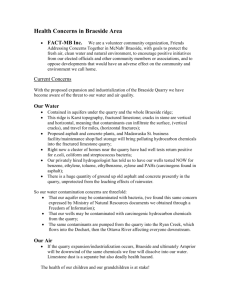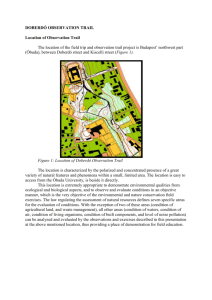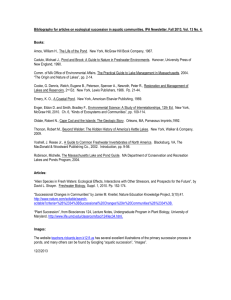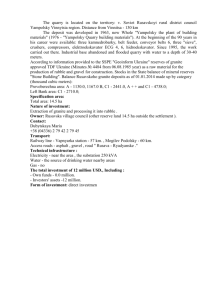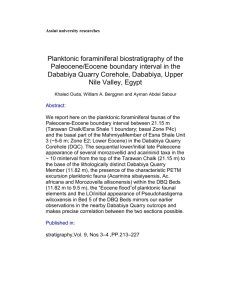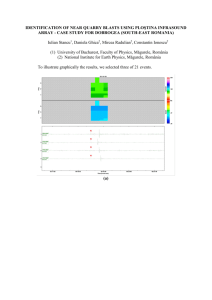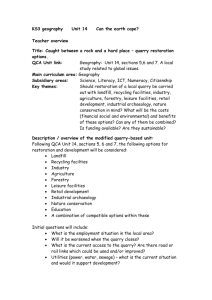Quarry Trail – Points of Interest
advertisement
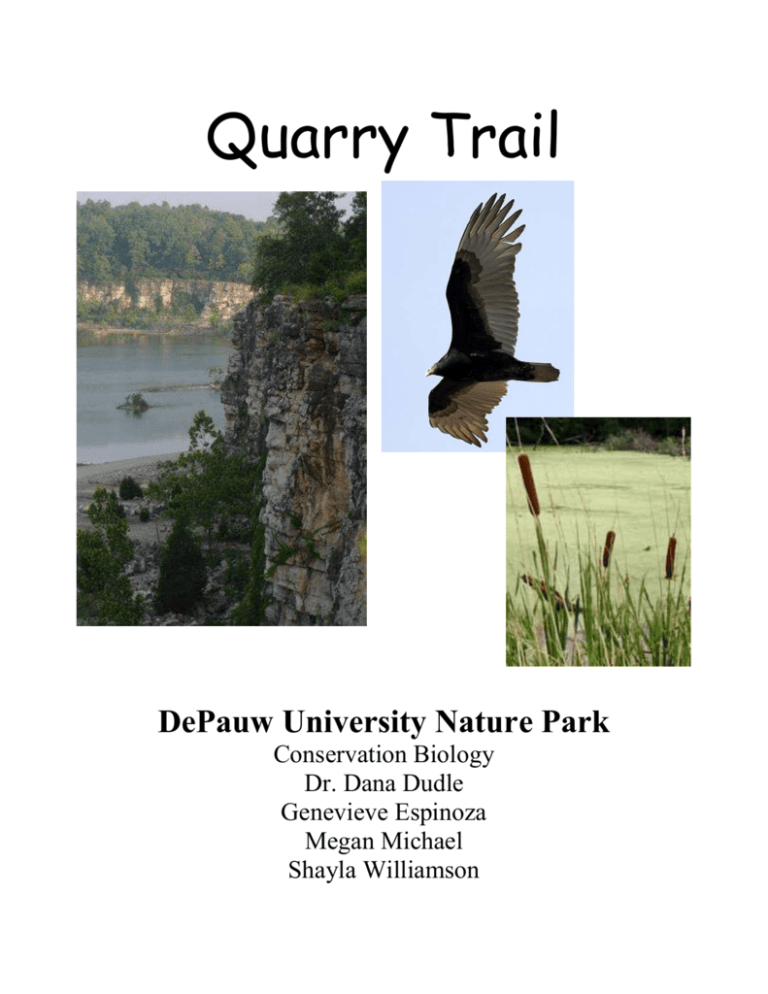
Quarry Trail DePauw University Nature Park Conservation Biology Dr. Dana Dudle Genevieve Espinoza Megan Michael Shayla Williamson GUIDE TO THE NATURAL HISTORY OF THE QUARRY TRAIL Introduction and Quarry History DePauw acquired the Nature Park in 2003 with a total of approximately 500 acres of land. The DePauw Nature Park consists of mid-successional woodlands, Big Walnut Creek, ephemeral and permanent ponds, the quarry bottom, and wetlands. In 1917 the Nature Park was site to the Hanson Aggregates mining company. In 1977 the quarry was finally closed and abandoned due to the discontinued function of the New York Central railroad that exported and distributed the aggregated limestone from the site. The railroad once existed on the quarry bottom to the western side of the trail. This trail guide takes you through a mile of marked points of reclamation work, conservation biology interests and processes, and ecological diversity as a result of human impact. 1. Limestone Walls You are about to enter a cross-section of millions of years of geological work by the earth’s processes. The limestone rock began forming 350 million years ago when a shallow sea covered most of Indiana in the Mississippian Period. Layers of marine fossils can still be seen in the limestone quarry walls, especially in the southern end of the quarry bottom. The exposed walls of the quarry were blasted during the mining of the limestone in from 1917 - 1977. Most of the rock is still unstable due to the blasting, as can be seen by the recently fallen rocks at the bottom of the trail. The extracted limestone, known as aggregate, was distributed by the mining company using the railroad that ran what is now the Nature Park’s parking lot and Rail Trail. Interestingly there are caves and sinkholes that form naturally in the limestone sediment throughout the Nature Park but most of the caves cannot be seen from the trail. 2. Eastern Red Cedar Scientific Name: Juniperus virginiana Family: Cupressaceae (Cypress) Because the quarry bottom is composed of infertile soils, deeply excavated and scarred areas, the Eastern Red Cedar is an common species. The Eastern Red Cedar provides vital shelter for birds and mammals in the winter. Its aromatic qualities have been used to make perfumes and this species is used for fence posts, chests, and carvings because it is extremely resistant against harsh conditions. The oils from the cedar were used for medicinal purposes. The cedar is found in dry uplands especially limestone, and even swamps ranging from Canada to Texas. It is an evergreen tree with a narrow, columnar crown. The leaves are scale-like, (not toothed) and dark green with fruity soft blue cones on females and tiny tancolored cones on the branches of males. The bark is reddish-brown, thin, fibrous and looks shredded. Eastern Red Cedars of all sizes can be spotted throughout the Quarry, and perhaps we should admire them for their resistance and ability to adapt to conditions that for most plants would be unsuitable. 3. Wetlands Off to the right side of the trail, wetlands have formed unnaturally. During the construction of Wal-Mart distribution center in 1990, Hanson Aggregate allowed concrete and soil waste to be disposed of at the quarry. As a result, the saturated soil does not allow water to dissipate or dissolve below into the ground. The excess water forms shallow ponds or soggy land. Generally, wetlands are low-lying areas covered or saturated by water with grasses and animal species tolerant of the high moisture content. 4. Turkey Vultures – Scientific name: Cathartes aura. If you look up to the rim of the quarry, you will often see these vultures soaring or roosting in the trees along the edge. Sometimes you can see as many as 20 turkey vultures soaring at once, riding the circulating currents of air above the quarry pit. While these birds usually eat carrion (dead and decaying flesh) allowing them to serve as “nature’s janitors,” it may be a surprise to know that they enjoy plant matter as well. They are also considered gentle and nonaggressive animals. Their bald head allows them to remain clean and avoid bacteria while eating their prey. Buzzards are not vultures – they are actually hawks! Turkey Vultures Another bird that has been spotted in the quarry is the Charadrius vociferous (Killdeer). This bird is 8-inch long, long-winged shorebird is medium in size with a short and thick dark bill. It has fleshly colored legs and a rusty-red behind. Its most defining characteristic is the red ring around its eye along with its white forehead and brown face. In this species, there are a lot of similarities between the juveniles and adults as well as the males and females. Its common call is "kill-deer, kill-deer, kill-deer." 5. Secondary Succession in the Quarry – Grasses and Goldenrods. If you look to your right, you will notice many slender wand-like plants that have beautiful golden flowers in the fall. The grasses and goldenrods are indicative of an early stage of secondary succession, which occurs after a disturbance in an area that removes plant life but not the soil. This is often referred to as "old-field succession" because it can be compared to an abandoned field that was invaded by a variety of plants, like the grasses and goldenrods. Goldenrods tend to successfully out-compete other plants, probably because of their ability to make many flowers, and to reproduce asexually. Hundreds of mini-florets, each capable of producing offspring, are found within one flower. Meanwhile, the plants can produce several exact copies of themselves by cloning, each season. This gives the species strength in numbers and it will probably dominate the field for a while. The next step of succession would occur when tree seedlings eventually invade the field and the site will gradually transition from grassland to forest. If we came back in 200 or 500 years, then this site may be covered with deciduous forest (if humans do not otherwise change the habitat). Goldenrods 6. Road cutting through pond- This road was built after DePauw acquired the quarry to serve as a bridge for those traveling through this trail. The trail path splits the pond because rocks fall from the cliff’s edge as a result of the limestone’s instability. Those who built the trail wanted to keep hikers away from the edge of the cliff in order to avoid falling rocks. From this point, you can also see cattails (Typha augustifolia), which are very common in Indiana Wetlands. Standing 1 to 3m tall, they are typically the first step in converting bodies of water to marshland. Instead of typical roots, they have rhizomes- roots that grow horizontally to expand the colony. Canadian geese (Branta canadensis) and other migratory birds are often found in the quarry pond. They commonly rest here on their way south. The species of Canadian geese that stay in Indiana year round are giant Canada geese. They are primarily grazers, but occasionally eat fish and insect matter. They can fly at a range from 10-50mph hours and their average lifespan once they reach adulthood is 10-25 years. A migratory bird less commonly seen is the Snow Goose Chen caerulescens. 7. Quarry Pond – Have you ever wondered why the pond is not larger and deeper? An underground channel that was formed by a deliberate explosion limits its size. The channel runs through the bottom of the pond and takes the water to a nearby creek. The mining company blasted this channel in order to keep the entire quarry pit from filling with ground water. As a result, the quarry pond is always at the same level as Big Walnut Creek, which borders the Nature Park. Fish and Frogs – The following species of frogs and toads are found in the pond and surrounding area: Bullfrog (Rana catesbiana)- These frogs make a call with deep bass notes and can be heard up to ¼ mile away. They are 3 ½ to 6 inches long and are typically a plain green color. Blanchard’s Cricket Frog (Acris crepitans)- Much smaller than bullfrogs, these range from 5/8 – 1 ½ inches. Their calls can be described as “two steel balls clashing together” and then picking up in speed. They are typically light brown with grey and green speckles. Spring Peeper (Pseudacris crucifer)- Similar in size to the cricket frog, these are tan or brown in color, with the ability to change color with in fifteen minutes. Spring peepers have moderately webbed feet and noticeable disks on their fingers and toes. True to their name, their call is “peep, peep, peep.” American Toad (Bufo americanus)- Full-grown toads range from 2" 3.5" and they can be brown, gray, reddish or olive in color. 8. As you turn the corner, you will notice that the edge of the cliff wall looks slightly damp. On any dry day, you will notice that the dampness is caused by water seeping through the rock. The quarry as a whole has been undergoing primary succession since the mine was abandoned about 30 years ago. Primary succession is the colonization of bare rock by plants, animals, and other organisms. In primary succession, plants that are adapted to a very harsh environment (that lacks soil nutrients, water, and shade) begin to "normalize" the habitat, creating conditions nearer the optimum for plant growth. One of the first events in primary succession includes the formation of organic matter, as the first colonizing plants die and break down, and as their roots pulverize the surrounding limestone into clay. The “pioneer plants” you see now may later be replaced by plants like grasses and shrubs that require less stressful conditions. 9. Temporary ponds – As you walk further, to your right you will notice a temporary pond. Temporary ponds are formed by shallow depressions, excavations, small creek meander scars, quarries, and roadside ditches. These ponds fill with rainwater during the fall and/or early spring. Organisms that live in the ponds must complete the aquatic portion of their life cycle before the ponds dry in the summer. Many aquatic invertebrates and amphibians spend part of their lives in the ponds. During the spring and summer months, they move among ponds, eating different aquatic organisms including amphibian eggs and larvae. The animals that have been seen in temporary ponds here in the nature park are typically the same frogs and toads found in the larger quarry pond. 10. Sycamore Scientific Name: Platanus occidentalis Family: Platanaceae (Plane Tree) While walking in the Nature Park you will see large white trees, thinking they might be dead, but in the forest and along the river, Sycamores are actually beautiful ornamental, shade trees that really serve as nesting sites for small animals and birds. People also use sycamore for furniture, crafting, and wood flooring. These trees have twisting branches and are characterized by large leaves and scaly or flaky white bark. The brown balls with long a long stalk and many narrow nut lets are formed as fruit and mature in autumn. In the quarry, the sycamores are much smaller, due to the harsh conditions and recent abandonment of the mine. Sycamores are often found in floodplains, old fields, and abandoned strip mines from the east coast to Florida and Texas. Their ability to endure the acidic soil composition, low levels of fertilizer, and poor conditions make Sycamores adaptable and important to the reclamation of land. 10. Temporary ponds – As you walk further, to your right you will notice a temporary pond. Temporary ponds are formed by shallow depressions, excavations, small creek meander scars, quarries, and roadside ditches. These ponds fill with rainwater during the fall and/or early spring. Organisms that live in the ponds must complete the aquatic portion of their life cycle before the ponds dry in the summer. Many aquatic invertebrates and amphibians spend part of their lives in the ponds. During the spring and summer months, they move among ponds, eating different aquatic organisms including amphibian eggs and larvae. The animals that have been seen in temporary ponds here in the nature park are typically the same frogs and toads found in the larger quarry pond. 11. Phragmites –To the left and right, you can see a large patch of Phragmites ( Phragmites australis), which is a water reed. While similar to cattails in appearance, they are much taller, growing up to 13 feet in height. Phragmites is an invasive species, originally introduced to North America from Asia. Invasive species are those that have been introduced by human action to an area where they did not previously occur naturally and that spread widely throughout the new location. They are often problems because they outcompete other native species, or may spread faster than they do in their native habitats. In the quarry, Phragmites may be outcompeting the native cattails. Sources Davis, B.N.K., (edr), Ecology of quarries. The importance of natural vegetation. Institute of Terrestrial Ecology Symposium pp11-77.1981. Depauw University Nature Park Website: www.depauw.edu/univ/naturepark Environmental Protection Agency: www.epa.gov/owow/wetlands/pdf/overview.pdf Great Plains Nature Center: www.gpnc.org/eastern.htm Lippert, Byron. David Jameson. Plant Succession in Temporary Ponds of the Willamette Valley, Oregon. American Midland Naturalist. (71)1 pp. 181-197. 1964. www.gnpc.org/sycamore.htm Indiana Division of Wildlife: www.in.gov/dnr/fishwild/hunt/geese/geesefacts.html www.ship.edu/~tjmare/ponds.html Secondary Succession: www.wikipedia.org/wiki/Secondary_succession http://news.nationalgeographic.com/news/2001/06/0621_vultures.html http://aquat1.ifas.ufl.edu/phraus2.jpg **Special thanks to DePauw University and The Cinergy Foundation for funding this project.
